市场资讯及洞察
.jpg)
最近很多新闻都在疯狂炒作13F公布的美股大空头Michael Burry的空头持仓,因为在公布的持仓当中显示Michael Burry通过期权大量看空英伟达和Palantir两家AI行业的风头企业。
Michael因为在08年的次贷危机中大幅看空美国的地产行业通过金融衍生品CDS的互换合约在08年全球性的金融危机中大赚特赚了一笔而成名,此后根据其真实经历改编的电影《大空头》更是风靡全球。
近期从监管部门的公开资料中显示Michael Burry管理的Scion在2025年的Q3披露文件中显示买入了大量的英伟达和Palantir 的看空期权,其中1.87亿美元看空英伟达,9.12亿美元看空Palantir,市场也被这波操作吸引带动,两家公司股价承压后连续下挫,甚至是Palantir的CEO在社媒上破防怒斥为何要做空那些赚的盆满钵满的公司?
其实实际情况是媒体在新闻上喜欢噱头来博取眼球,看似8成仓位押注两家AI企业暴跌的持仓实际上是他持仓的看空期权的名义价值,而真实对应的期权成本可能远远小于实际情况。Michael习惯性的运用金融衍生品工具的特性,利用可控范围的风险对可能产生的AI泡沫破裂进行重要压注。并不是说他真的把80%管理的资产押注在了两家风头正盛的公司的暴跌上,而且因为相关信息的缺失,什么时候离场,以及是否在对冲其他持仓等因素其实外界并无法确切知悉,所以现在就对美股AI报以极度悲观的态度是非常情绪化且不准确的。

而根据Michael自08年以后的投资来看其交易实际上并不是每次都很准,具体总结如下:
- 2015年12月预测股市崩盘:Burry在2015年底公开警告股市将在未来几个月内崩溃然而,S&P 500在随后一年(2016年)上涨约11.96%
- 2020年3月重注看空市场:Burry在疫情初期下重注做空但从2020年3月低点起,美股在12个月内反弹约72%这被视为他的重大失误之一。
- 2022年9月警告股市未触底:Burry在9月发推警告市场将持续“失败“,尚未见底但从2022年9月到2023年8月,S&P 500反弹约21%他的预测又一次“早于市场“。
- 2023年1月敦促“卖出“:Burry在1月底发单字推文“Sell”,预言经济衰退和新通胀浪潮,结果,S&P 500在2023年全年上涨约24.23%,远超他的悲观预期。
那对于普通投资者究竟如何合理看待这种明星基金经理的持仓呢?
其实大部分资管公司都有自己的持仓和投资逻辑,无论是多还是空,可能都是整体布局的一个部分,媒体放大一个角落使得很多投资者在面对相关问题时显得管中窥豹一般无法总览全局,从Michael的一系列表态中也可以看出他虽然暗示了本轮AI的泡沫和2000年科网崩盘存在相似性,将其作为对市场的警告或许不失为一种合理的看待方式,但是这并不意味本轮AI的发展和走势就将戛然而止,AI的发展或将在接下来更长期的时间里影响每一个人的生活。
免责声明:GO Markets 分析师或外部发言人提供的信息基于其独立分析或个人经验。所表达的观点或交易风格仅代表其个人;并不代表 GO Markets 的观点或立场。
联系方式:
墨尔本 03 8658 0603
悉尼 02 9188 0418
中国地区(中文) 400 120 8537中国地区(英文) +248 4 671 903
作者:
William Zhao | GO Markets 墨尔本中文部


CPI is a globally recognised economic indicator used by many countries to measure inflation and assess changes in the cost of living for their citizens. It evaluates the average change over time in the prices paid by urban consumers for a market basket of consumer goods and services, such as food, clothing, rent, healthcare, entertainment, and transportation. Compiled by national statistical agencies or organisations in various countries, the CPI reflects the purchasing power of a country's currency.
By monitoring CPI trends, policymakers and economists gain insights into the overall economic health, make informed decisions about monetary policy, and understand how price changes impact the general population's standard of living. In an international context, different countries might have their own versions of CPI tailored to their specific economic circumstances and consumer behaviours. However, the fundamental concept remains consistent: CPI measures the average change in prices paid by consumers, making it a crucial tool for understanding inflationary pressures and making economic comparisons across nations.
Key takeaways CPI functions as a universal tool used by countries around the world to measure inflation and evaluate changes in the cost of living. Here are the key points in this global perspective: Global Measurement of Consumer Prices: The CPI serves as a global standard for measuring changes in the prices of goods and services consumed by households. Each country typically has its own CPI, tailored to its specific consumption patterns, demographics, and economic structure.
Universal Indicator of Inflation: Internationally, the CPI is universally recognised as a crucial indicator of inflation. Central banks, policymakers, economists, and businesses in various countries closely monitor CPI trends. It helps them understand the impact of price changes on their economies and make informed decisions about monetary policies and economic strategies.
Diverse Basket of Goods and Services: The CPI in different countries includes a diverse basket of goods and services that are essential to the local population. This basket is regularly updated to reflect contemporary consumption habits, ensuring that the CPI accurately represents the changing cost of living for people. Data Collection and Analysis: Countries globally conduct extensive data collection efforts to calculate their CPI.
This involves collecting price data from various sources, including retail outlets, service providers, and housing markets. The data collected provides valuable insights into the purchasing power of the local currency and helps assess the economic well-being of citizens. Policy Implications: CPI data influences policy decisions not only at the national level but also in international trade and finance.
It affects decisions related to interest rates, social welfare programs, and economic reforms. Moreover, it plays a significant role in international economic comparisons, enabling policymakers to assess their country's economic performance relative to others. Understanding the CPI For example, the US has the Bureau of Labor Statistics (BLS) conduct extensive data collection efforts to create the CPI data, gathering approximately 80,000 price points every month from 23,000 retail and service outlets.
Despite both CPI variants having the term "urban" in their names, the more comprehensive and widely referenced version covers 93% of the U.S. population. Within the CPI, the housing category, which constitutes a significant one-third of the index, is determined through a survey of rental prices for 50,000 housing units. This data is then utilised to calculate the increase in rental prices as well as the equivalent costs for homeowners.
In particular, the owners' equivalent category factors in the rent equivalent for owner-occupied housing, ensuring an accurate representation of housing expenses in consumer spending. It includes user fees and sales or excise taxes but excludes income taxes and the prices of investments like stocks, bonds, or life insurance policies from CPI calculations. The calculation of CPI indexes incorporates several important considerations.
Firstly, it accounts for substitution effects, recognising that consumers tend to redirect their spending when certain products or categories become relatively more expensive. Additionally, the calculation adjusts price data to accommodate changes in product quality and features, ensuring a more accurate representation of actual consumer spending. Moreover, the weighting of product and service categories in the CPI indexes is based on recent consumer spending patterns, derived from a separate survey.
This weighting reflects the significance of different items in the average consumer's budget, providing a realistic portrayal of how expenditure is distributed across various goods and services. By integrating these factors, CPI indexes offer a nuanced and precise measurement of changes in the cost of living for consumers. CPI Categories The monthly CPI released by the BLS provides a comprehensive overview of economic changes.
This report highlights alterations from the previous month for the overall CPI-U and its significant subcategories, including the unadjusted year-over-year changes. The BLS detailed tables further break down price shifts for a wide array of goods and services grouped under eight overarching spending categories. These detailed tables allow for precise analysis, estimating price variations for items ranging from everyday groceries like tomatoes and salad dressing to services such as auto repairs and sporting event tickets.
For each subcategory, both seasonally adjusted and unadjusted price changes are provided, offering a nuanced understanding of consumer spending patterns. Beyond the national CPI indexes, the BLS also publishes CPI data for US regions, sub-regions, and major metropolitan areas. Notably, metropolitan data can exhibit more significant fluctuations, primarily serving the purpose of identifying localised price changes based on unique regional conditions.
What Makes CPI Significant for Currency Traders? The CPI indicator, often termed "headline inflation" in markets, holds immense significance in the realm of currency trading. This is primarily because inflation has a profound impact on the decisions taken by central banks concerning their monetary policies.
Central banks, like the Federal Reserve and the Bank of Japan, typically have a mandate to maintain inflation at a specific level, often around 2.0% annually (source: the Fed, BOJ). To achieve these targets, policymakers adjust interest rates, employing them as a mechanism to attain the desired inflation levels. Additionally, they might implement other strategies such as bond-purchasing agreements or expanding the money supply.
When inflation levels deviate from these targets, it serves as an important signal for central banks to consider altering interest rates. If inflation exceeds the 2.0% target, central banks like the Federal Reserve might increase interest rates to curb excessive spending. This, in turn, strengthens the dollar against other currencies since a higher interest rate makes the U.S. currency more attractive.
Furthermore, CPI serves as a forward-looking indicator of an economy's performance. In instances where inflation rises sharply, as witnessed in countries like Brazil and Venezuela in recent years, consumers tend to save less as their purchasing power diminishes. This dynamic reflects the broader economic landscape and significantly influences market behaviours and currency values.
When a central bank raises interest rates to counter inflation, it usually leads to a reduction in borrowing. Both individuals, seeking loans for purchases, and businesses, aiming to expand their operations, tend to cut back on borrowing due to the higher cost. This decrease in borrowing activity can have significant implications for a nation's overall Gross Domestic Product (GDP).
How CPI Data Affects the Dollar on the Forex Market? The Federal Reserve operates under a dual mandate: to achieve full employment and maintain a stable, healthy rate of inflation during economic expansion. Consequently, forex traders closely watch both unemployment and inflation data, as these figures influence the central bank's decisions on adjusting interest rates—decisions that significantly affect currency strength or weakness.
Forex traders regard the CPI and Core CPI figures as pivotal indicators for gauging an economy's performance. Among these, Core CPI provides a more insightful perspective by excluding volatile energy and food prices. In the United States, the Labor Department releases these figures, excluding energy and food costs from the measurement.
If the Core CPI surpasses market expectations, the dollar typically strengthens against other currencies. Conversely, if these readings fall short of consensus forecasts, the currency weakens relative to other pairs. Importantly, the impact extends beyond the monthly report.
Like all government data, CPI figures are subject to revisions by economists. Such revisions can spark significant volatility in a currency's value on the global market. This continuous assessment of economic indicators shapes traders' strategies, highlighting the vital role of CPI data in the forex market.
Conclusion CPI is a pivotal measure reflecting pricing dynamics within an economy and serves as a reliable indicator of inflation. Forex traders keenly observe the CPI because it often prompts adjustments in monetary policies by central banks. These policy changes can either bolster or diminish a currency's value relative to its counterparts in the markets.
Additionally, the strength or weakness of a currency profoundly influences the earnings of companies operating in diverse global markets, making CPI a key metric watched closely by both traders and businesses.


Retail sales play a fundamental role in shaping the economic landscape of any country. These sales represent the culmination of consumer demand for finished products, serving as a barometer for economic health and a predictor of market trends. In the United States, this vital metric is meticulously tracked and reported monthly by the U.S.
Census Bureau, making it a cornerstone of economic analysis. Diverse Scope of Retail Sales Data Retail sales data encompasses a wide array of transactions, including both durable and non-durable goods, within a specific timeframe. These transactions emanate from 13 distinct types of retailers, ranging from food services to retail stores.
This broad spectrum of goods and services reflects the intricate tapestry of consumer spending habits, providing invaluable insights into market behaviour. Unravelling the Significance Retail sales offer more than just a glimpse into consumer preferences; they provide a macroeconomic perspective on consumer demand for finished products. By compiling data on durable and non-durable goods, the retail sales report becomes a powerful tool for analysts and investors.
These figures serve as a pulse check for the economy, guiding decisions by shedding light on economic health and identifying potential inflationary pressures. The U.S. Census Bureau's meticulous gathering of data from various establishments ensures the accuracy of retail sales metrics.
This accuracy is imperative due to the pivotal role consumer spending plays in the U.S. economy. Consumer spending, also known as Personal Consumption Expenditure (PCE), constitutes a staggering two-thirds of the country's gross domestic product (GDP). Therefore, understanding retail sales is not just a matter of economic analysis; it is essential for gauging the overall economic well-being of the nation.
Decoding Retail Sales: Insight into Economic Vitality Retail sales do not exist in isolation; they are intertwined with broader economic trends, offering a window into the vitality of the economy. These figures, reported by food service and retail stores, are meticulously compiled by the U.S. Census Bureau.
Utilising sophisticated data sampling techniques, these measurements are extrapolated to model nationwide patterns, providing a comprehensive view of consumer behaviour. The categories of retail sales are diverse, spanning in-store, catalogue, and out-of-store sales of both durable and non-durable goods. This diversity highlights the multifaceted nature of consumer preferences and purchasing behaviours.
From clothing and pharmaceuticals to electronics and furniture, retail sales encompass a myriad of products, each reflecting distinct market dynamics. Influence of Inflation: Navigating Economic Challenges Inflation, a ubiquitous economic phenomenon, significantly impacts retail sales. As prices of goods and services rise, consumers are compelled to recalibrate their spending habits.
Higher inflation often leads to a reduction in overall expenditures, with consumers prioritising necessities and purchases resistant to inflationary pressures. This adjustment underscores the intricate dance between economic forces and consumer behaviour, shaping the trajectory of retail sales figures. Special Considerations in Interpreting Retail Sales Data Interpreting retail sales data requires a nuanced understanding of various factors.
The U.S. Census Bureau's Monthly Retail Trade Survey, released mid-month, provides detailed insights into total sales, accompanied by percentage changes from previous reports. To account for seasonal fluctuations, the report includes year-over-year changes, offering a comprehensive view of consumer-based retail trends.
Economists and analysts face the challenge of interpreting retail sales figures accurately. One such challenge lies in the inclusion of auto and gas sales, both of which are volatile categories. Many experts prefer analysing retail sales data excluding these segments, considering their propensity to fluctuate unpredictably.
Gas station sales, influenced by oil and gas price volatility, are particularly prone to sharp shifts, making them a less reliable indicator of consumer behaviour. Seasonality and Retail Sales: The Impact of Festive Seasons Seasonality significantly shapes retail sales patterns, with the holiday season, notably Christmas, witnessing a surge in consumer spending. This festive period accounts for a substantial portion of annual sales, especially for retailers specialising in hobbies, toys, games, and department stores.
Recognizing these seasonal fluctuations is essential for a nuanced interpretation of retail sales data. It underscores the cyclical nature of consumer behaviour and its intersection with cultural and economic factors. Calculating Retail Sales Data: Precision in Reporting The U.S.
Department of Commerce's Census Bureau plays a pivotal role in compiling and disseminating retail sales figures. Through its Monthly Retail Trade Survey, the Bureau meticulously collects data, summarising the previous month's sales activity. This precision in data collection ensures the accuracy and reliability of retail sales metrics, providing a foundation for informed economic analysis.
The Bottom Line: Retail Sales as Economic Barometer In essence, retail sales represent far more than mere transactions; they encapsulate the collective choices and behaviours of consumers, offering a nuanced portrayal of economic health. As a leading macroeconomic indicator, retail sales serve as a compass, guiding investors, policymakers, and analysts through the complex terrain of economic trends. The surge or decline in retail sales figures echoes the heartbeat of the economy.
Increasing retail sales signify a robust and expanding economy, eliciting positive movements in equity markets. Shareholders of retail companies welcome these high sales figures, indicating enhanced earnings and market stability. However, the story is not devoid of complexities.
Bondholders, sensitive to economic nuances, exhibit mixed sentiments. While a flourishing economy benefits all, lower retail sales and economic contraction can lead to reduced inflation. This prompts investors to turn to bonds, potentially increasing bond prices as they seek stability in the face of economic uncertainty.
In conclusion, understanding retail sales is akin to deciphering an intricate economic code. It requires a keen eye for detail, an understanding of market dynamics, and an awareness of the broader economic landscape. Retail sales are not just numbers on a report; they encapsulate the aspirations, choices, and challenges of a nation's consumers.
By delving into the nuances of retail sales data, analysts and investors gain invaluable insights, enabling them to navigate the ever-changing currents of the global economy. As a barometer of economic health, retail sales continue to be a beacon, guiding stakeholders toward informed decisions and a deeper understanding of the intricate web of economic interactions.


热门话题在说了很多上市公司以及宏观环境之后,今天我们又回到了单个产品上。还是说说咱们都关心的澳元走势。大家都知道,澳元在过去4,5个月的时间里,其走势就如同是王小二过年,那是一年不如一年。为啥曾经一度价值甚至超越美元的澳元,如今却沦落到如此这般田地呢?是人性的扭曲,还是道德的沦丧?让我们一起走进今天的文章,给您来详细的马后炮一把。作为南半球最发达国家的澳洲,一直以来都以矿业丰富,人口稀少而著称。也正是因为澳洲地下蕴含着巨大的矿业资源,因此仅仅依靠着铁矿石和铜,澳洲在过去20年里就成为了发达国家里经济发展平均增速最快,持续发展而没有衰退时间最长的国家。从2000年悉尼的奥运会到现在2023年,澳洲已经成为人均GDP超越英法德日加,接近美国的水平。放眼全世界,也只有例如瑞士芬兰卢森堡这样的小国在人均GDP上超越澳洲,以正常大国范围来看,澳洲几乎已经达到了非常高的水平。
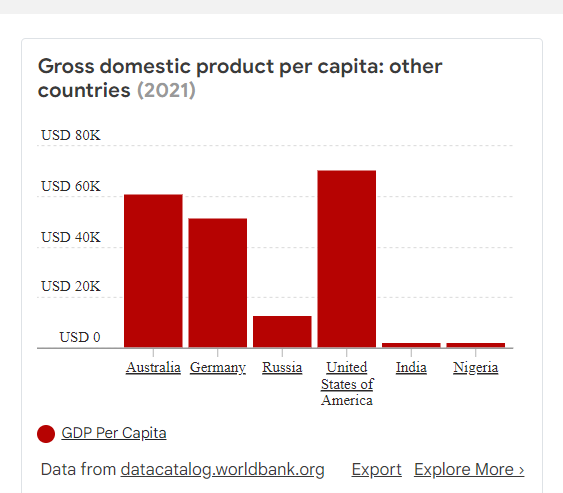
但是澳洲过去20年的成功,很大程度上是依靠着成为中国基建的供货商来实现的。在中国加入世贸后的20年,其城镇化建设高速发展,因此对于钢铁煤炭和其他主要工业原料的需求大增,而澳洲,连同智利,巴西一起,成为了中国工业化道路上的主要供货商。而其中澳洲又因为矿石品质最好,人口最少,因此获利最多。但是也由于主要出口给中国,使得澳洲的矿业出口过度集中,为之后因为中国订单锐减而大幅亏损埋下了隐患。大家回忆一下,澳元和美元汇率最高的时候是什么时候?就是在2011年金融危机之后的那几年。之后随着美国经济的恢复,澳元的价值也一路下跌。一直到2020年疫情开始时澳元和美元最低只有0.55。以及2022年10月中国疫情清零政策放弃,全国感染率激增的时候,澳元的汇率也下跌到了0.61. 从这两次可以看得出,澳元每次下跌,都是在市场对于中国经济担忧加剧的时候。换而言之,如果国际投资者觉得中国未来的情况可能会更加不乐观,那澳元的下跌走势就不会停止。我从2015年到现在一直重复我对澳元走势的看法:我个人认为,影响澳元最大的三个因素从影响大到小的排列是:1. 铁矿石价格,2. 中国经济好坏,和3.美元政策(加息还是降息)以下就是铁矿石的走势图
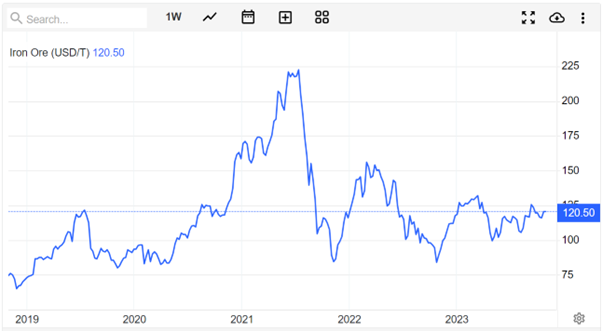
从2021年高点到现在价格已经跌了50%。虽然几乎和2019年差别不大。但是大家需要记住,过去3年每年的通货膨胀可是在7%左右,也就是说,物价3年里上涨了21%。因此如果现在的价格和疫情之前一样,就意味着实际价格已经下跌了20%。至于第二个中国经济的情况,相信不用多说,我们也应该都能感觉到经济下行的压力很大。作为过去一直支撑GDP的房地产行业,随着恒大和许家印最终的下台,也迎来了一个巨大的回调期。而作为各地主要财政来源,土地拍卖在今年也进展不顺。当然,从大方向来看,随着和去年相比疫情限制政策的完全打开,以及以马云回归为代表的一系列支持民企重新发展的动作出台,中国未来几年至少在民营经济层面,将会出现一个过去5年难得的宽松期。希望各行各业可以在政策有利时期,可以抓住时机,为经济多创造就业,为千万普通百姓家庭创造一个可以生活的机会。其实从2007年工作到现在,见证了世界金融危机,见证了欧债危机,见证了澳元的疯狂,也见证了2020年后3年的痛苦。过去1年,咱们澳洲华人金融企业也是频频出事,搞得大家人心惶惶,似乎再也不敢碰华人的企业了。虽然GO Markets是澳洲本地公司,而且70%是澳洲英文客户,但是我们的中文部一样也会受到这类事件的影响。客户会担心,会怀疑所有只要是华人的金融企业。我知道短期内这无法改变。但是我希望未来会有更多华人企业,愿意做稳,做长久,不要追求短期的爆炸式发展,也不要追求短时间的利润翻翻。信任这东西,需要几年,甚至更长时间来建立,但是要毁掉它,真的是分分钟,甚至一句话,一件事就行。扯远了。说回到澳元。澳元目前三大因素里,铁矿石疲软,中国经济疲软,而美元则因为战争,加息等多重因素在过去6个月继续走强。这样反过来也给澳元不断施加了压力。当然了,澳元对于美元贬值其实是好事,因为这可以帮助澳洲出口的产品在交割美元后可以换回来更多的利润。但是和美元加息完全根据自己国家情况有所不同的是。澳洲现在面临一个非常矛盾的情况:一方面澳洲当地的通胀还是很高,有5%左右,远高于目标的2%。理论上这是肯定要继续加息。然而在另一方面,由于中国经济下调,导致对于澳洲主要出口商品需求量下降,加上澳洲本地居民因为不断加息而消费减少。所以如果和美国保持加息幅度一样,澳洲会受到双倍伤害:来自自己居民消费降低的伤害,和来自于中国订单减少的伤害。所以澳洲在过去3个月才始终不太愿意加息。能不加就不加。但是最终结论还是那句话:在目前影响澳元最大的三个因素里,全部都不利于澳元。所以澳元的回调依然没有结束。只有当这三个因素出现一个,甚至两个变化后,澳元的回调才会改变。免责声明:GO Markets分析师或外部发言人提供的信息基于其独立分析或个人经验。所表达的观点或交易风格仅代表其个人;并不代表GO Markets的观点或立场。联系方式:墨尔本 03 8658 0603悉尼 02 9188 0418中国地区(中文) 400 120 8537中国地区(英文) +248 4 671 903作者:Mike Huang | GO Markets 销售总监


热门话题在过去的一年中,微软的2023财年创下了记录,实现了2110亿美元的收入和超过880亿美元的营业利润。2014年2月4日,萨提亚·纳德拉接管微软。当时,微软在市值上被苹果、亚马逊、谷歌、Facebook等公司超越,市值跌至2000亿美元。他重新定义了微软的使命:赋能全球每一个人、每一个组织,实现卓越。这一使命将四分五裂的团队凝聚在一起,开启了新的方向,为微软注入了新的活力和远大愿景,包括人工智能、混合现实和量子计算。到2019年9月,微软重新夺回市场第一的位置,市值已达到2.45万亿美元。

今天,我们将了解微软现任首席执行官纳德拉在最新的公开信中强调的几个要点。全人类正经历一个充满挑战和机遇的历史时刻。全球面临着持续的经济、社会和地缘政治不确定性。与此同时,我们迎来了新的人工智能时代,这项技术将从根本上改变全球每个人、每个组织和每个行业的生产力,帮助人类应对最紧迫的挑战。下一代人工智能将重塑每一个软件领域和每个企业,包括我们自己。拥有48年历史的微软仍然是一家具有深远影响力的公司,微软将继续专注于三个核心领域:首先,微软将继续在商业云领域保持领先地位,并在消费领域如游戏和职业社交网络等方面进行创新。其次,在平台转型的过程中,微软将强化在人工智能领域的领先地位,将这一技术融入技术的各个层面。最后,微软将持续提升经营效率,确保成本结构与收入增长相匹配。纳德拉认为人工智能的新时代由两个关键突破定义。首先是最通用的界面:自然语言。多年来,计算技术的持续发展一直受到对越来越直观的人机界面(如键盘、鼠标、触摸屏)的追求的影响。如今,我们相信我们已经跨越了下一个阶段,进入了自然语言的领域,即看、听、理解和解释我们的意图以及我们周围的世界。第二个突破是强大的新推理引擎的涌现。多年来,我们已经数字化了日常生活、地点和物品,并将它们整合到数据库中。这一代人工智能以更强大的方式与数据互动,从处理或总结文本到检测异常和识别图像,帮助我们更快地识别模式和提供见解。这两个关键突破将共同开启巨大的新机遇。微软将重新思考其客户解决方案和技术栈的每一层,以适应人工智能时代。这包括基础设施、数据和人工智能、数字和应用创新、业务应用、现代化办公、网络安全、搜索、广告和新闻,以及LinkedIn、游戏、设备和创意。这些领域将共同促进微软实现其长远目标。

在追求机遇的同时,微软也在努力确保技术成为解决问题的工具,而不是问题的根源。为实现这一目标,微软坚守四项长期承诺,这些承诺是微软使命的核心,尤其重要在这个新时代。对微软而言,这些承诺不仅仅是口头上的奉献。无论是在产品设计和开发、业务流程和政策制定,还是在帮助客户成功和建立合作伙伴关系等方面,它们都应该是微软决策的指南。微软会时刻审视自己的行为,确保符合这些承诺。在竞争激烈的经济环境中,过去的卓越成就已经不能满足今天的期望,微软的每一位员工都需要接受成长型思维,勇敢地突破传统思维。重新定义创新、商业模式和销售模式需要勇气。作为一家高绩效组织,微软致力于帮助员工最大化发展机会,同时帮助他们在专业上学习和成长,并将个人的激情和目标融入日常工作和公司使命。为了实现成功,微软必须根据客户和世界的需求行动。微软需要在创新和合作方面团结一致,以实现“一个微软”的愿景。微软需要积极寻求多样性和包容性,以更好地为客户服务,创造一种让每个人都能发挥最佳水平的文化。为了赋能世界,微软需要持续挖掘多样性的代表,并加强包容性文化。尽管在今年微软经历了各种挑战,但全球多样性程度创下了历史新高。作为一家公司,现在是微软展现实力的时刻。微软要负责任地打造解决方案,促进经济发展,造福每个社区、国家、行业和个人。只要微软做得好,整个世界就会更美好,微软也会取得更大成功。纳德拉对此充满信心。在未来的日子里,微软全体员工将携手努力,兑现这一承诺。免责声明:GO Markets分析师或外部发言人提供的信息基于其独立分析或个人经验。所表达的观点或交易风格仅代表其个人;并不代表GO Markets的观点或立场。联系方式:墨尔本 03 8658 0603悉尼 02 9188 0418中国地区(中文) 400 120 8537中国地区(英文) +248 4 671 903作者:Xavier Zhang | GO Markets 高级分析师


Meta Platforms Inc. (NYSE:META) announced its latest financial results after ther market close in the US on Thursday. Marc Zuckerburg’s company crushed analyst estimates for the quarter. Let’s take a closer look at how the company and the stock has performed.
The results Meta reported revenue of $34.146 billion for Q3 (up by 23% year-over-year) vs. $33.579 billion expected. EPS reported at $4.39 per share (up by 168% year-over-year) vs. $3.643 per share estimate. The company expects revenue of around $36.5 to $40 billion in Q4.
CEO commentary "We had a good quarter for our community and business," Mark Zuckerberg, CEO of Meta Platforms said in a statement to investors. "I'm proud of the work our teams have done to advance AI and mixed reality with the launch of Quest 3, Ray-Ban Meta smart glasses, and our AI studio," Zuckerberg added. The stock The stock was down by 3.73% at $288.35 a shon Thursday before the latest earnings were announced. However, the stock has experienced a tremendous year so far and is up by over 130% year-to-date.
Stock performance 1 month: -3.95% 3 months: -11.41% Year-to-date: +139.61% 1 year: +190.68% Mate Platforms stock price targets Truist Securities: $405 RCB Capital: $400 Piper Sandler: $355 Wedbush: $350 Wells Fargo: $380 Barclays: $400 Rosenblatt: $411 Keybanc: $380 JP Morgan: $400 Meta Platforms is the 7th largest company in the world with a market cap of $741.01 billion. You can trade Meta Platforms Inc. (NASDAQ:META) and many other stocks from the NYSE, NASDAQ, HKEX, ASX, LSE and DE with GO Markets as a Share CFD. GO Markets now offers pre-market and after-market trading on popular US Share CFDs, including Meta Platforms.
Trade the pre-market session: 4:00am to 9:30am, normal session, and after-market session: 4:00pm to 8:00pm, Eastern Standard Time. Why trade during extended hours? Volatility never sleeps.
Trade over earnings releases as they happen outside of main trading hours Reduce your risk and hedge your existing positions ahead of a new trading day Extended trading hours on popular US stocks means extended opportunities Sources: Meta Platforms Inc., TradingView, MarketWatch, Benzinga, CompaniesMarketCap


热门话题澳大利亚最新CPI数据显示,通胀略有放缓,但仍高于预期。9月季度CPI上涨1.2%,同比上涨5.4%。这使澳联储的通胀目标2-3%仍有差距。激进预测表示澳大利亚将有两次加息。


我们都知道澳联储一直在观察通胀情况,希望看到通胀放缓的迹象,以决定是否结束加息。然而,这次数据显然不达预期,市场反应来看,加息预期使得澳元短线走强,而澳股则下挫。

截至消息当日收盘,ASX200指数抹平早盘0.4%的涨幅,下跌0.04%,收于6854.3。
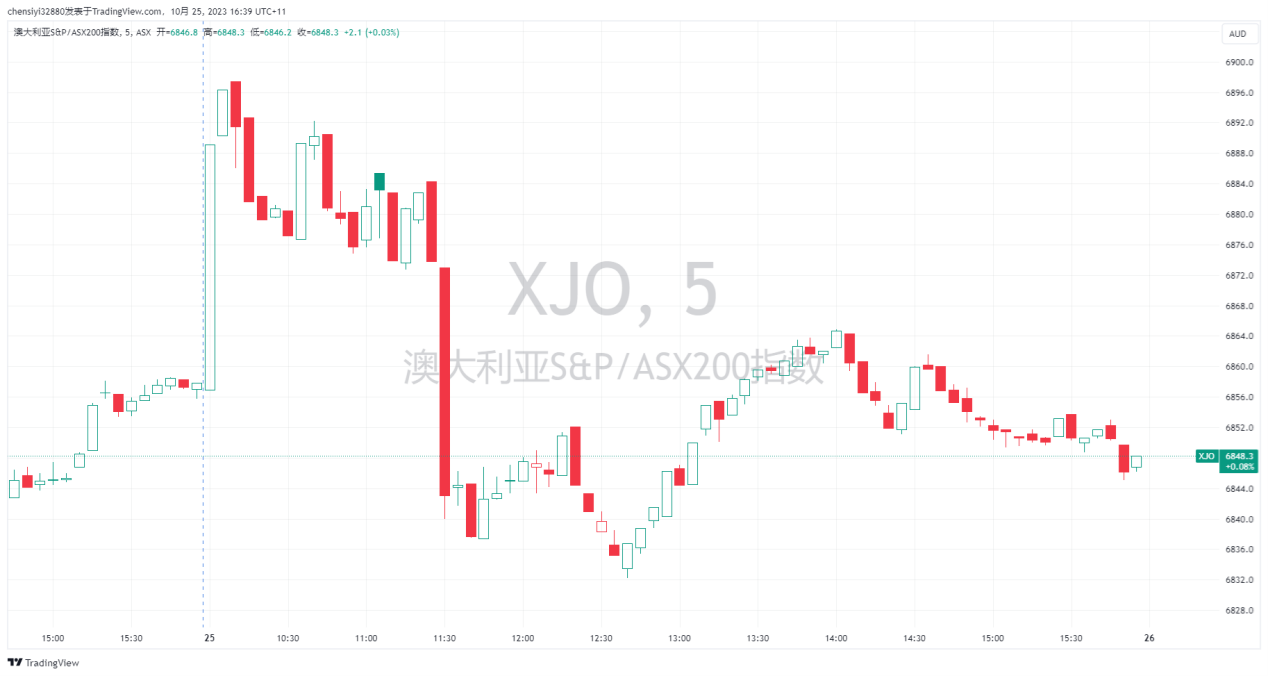
CPI数据分项显示,尽管通胀从峰值7.8%持续放缓,但大多数商品价格仍高于一年前。汽车燃料(+7.2%)、租金(+2.2%)、房屋购买(+1.3%)和电力(+4.2%)价格上涨是通胀主要原因。
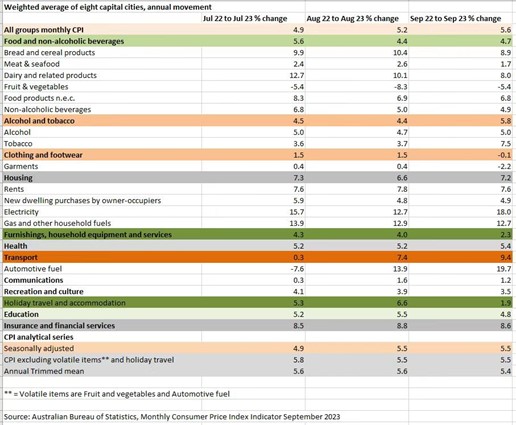
而服务业通胀率自2021年以来首次下降,但仍接近20年来的高点,达到5.8%。
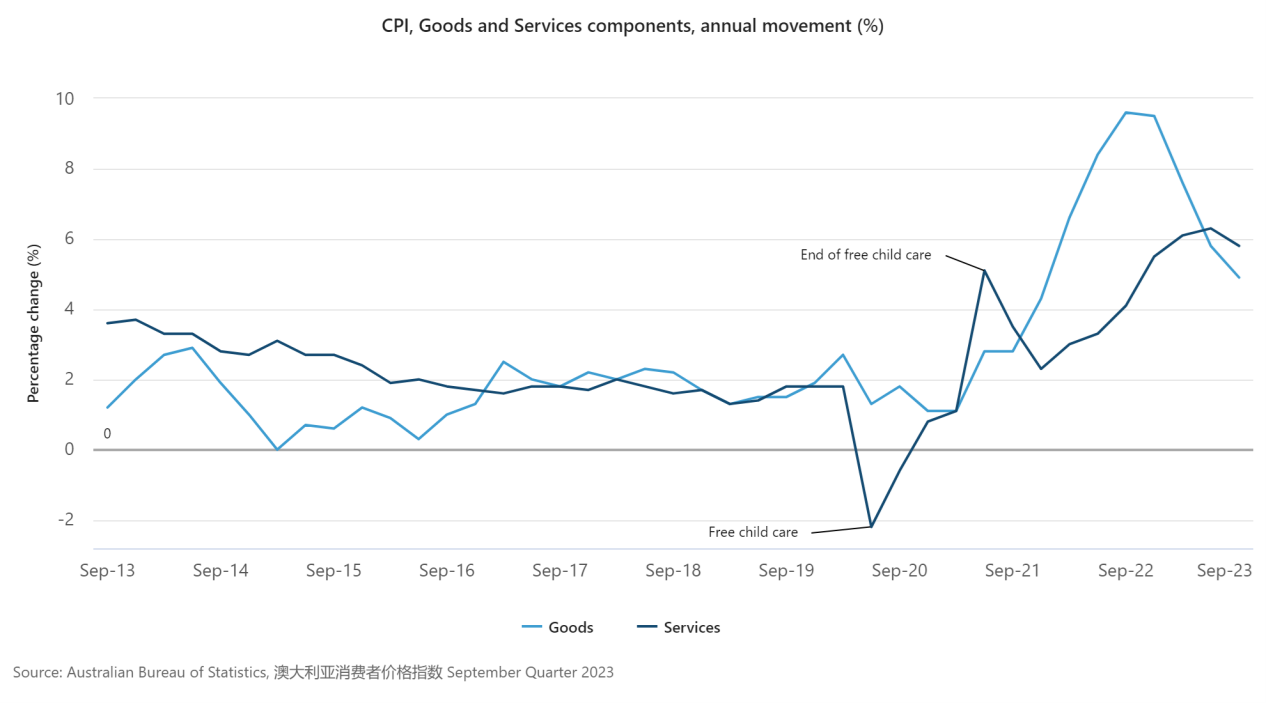
关注澳元的投资者都知道,澳元自7月以来持续下行。而如果澳央行真的继续加息,可能为大家带来短线交易机会。今天我们就给大家一次性梳理目前支持澳元上涨及下跌的理由。
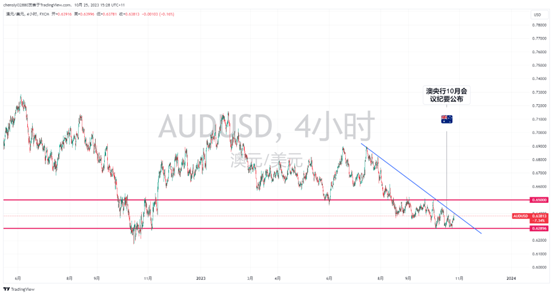
首先,澳元看涨离不开加息。根据目前的利率预期,澳洲至少还有一次加息,且利率将在长时间维持高位。物价数据公布后,德意志银行首席经济学家认为 11 月和 12 月将连续两次加息。ANZ、NAB和CBA的经济学家均预计,在11月7日的澳大利亚央行会议上,利率将上涨 25 个基点,达到4.35%。此外是澳央行对抗通胀的态度强硬。澳央行10月会议纪要重申对通胀上行的担忧,并表达继续收紧货币政策的意愿。当时就曾引领澳美短线上涨。

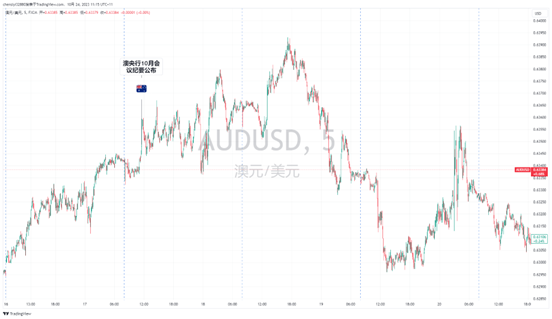
新任央行行长布洛克女士周二的讲话中也表示,如果通胀前景大幅上升,她将毫不犹豫地提高4.1%的现金利率。这表明澳央行货币政策走向将受到通胀数据的持续影响。澳央行在11月7日的联储会议上加息的话,澳元将受到提振。但同时,澳元的看跌理由方面,美元强势仍是绕不开的核心话题。当前,中东地缘政治的紧张局势给澳元带来了不利因素,美元一直以其避险吸引力而闻名施压澳元。此外,尽管澳大利亚央行自疫情低点以来已经加息了400个基点,但对比美联储加息525个基点。即使澳洲央行在11月加息,澳美利率差值仍然会阻挠澳元上涨路径。当然,谈到澳元不得不提到中国经济,澳大利亚高度依赖对中国的出口和贸易。因此,中国经济增长不及预期可能成为澳元基本面的一个关键利空因素。那么投资者们该如何交易呢?我们建议您可以把握短线双向交易机会。
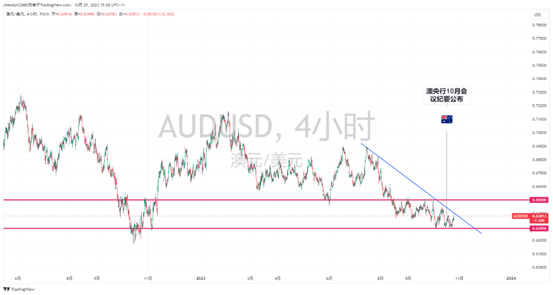
尽管澳元多头在过去的两个月中受到压制,但它在0.63美分附近进行多次测试,下方支撑水平0.62896美分表现出强劲支撑。澳央行后续如果加息有助于澳美突破下行趋势线,上方阻力0.65美分。年底前,澳元大概率会在0.63到0.65美分区间内波动,交易者可把握双向交易机会从中受益。免责声明:GO Markets分析师或外部发言人提供的信息基于其独立分析或个人经验。所表达的观点或交易风格仅代表其个人;并不代表GO Markets的观点或立场。联系方式:墨尔本 03 8658 0603悉尼 02 9188 0418中国地区(中文) 400 120 8537中国地区(英文) +248 4 671 903作者:Cecilia Chen | GO Markets 分析师

